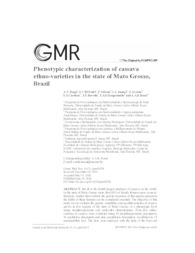Phenotypic characterization of cassava ethno-varieties in the state of Mato Grosso, Brazil.
Phenotypic characterization of cassava ethno-varieties in the state of Mato Grosso, Brazil.
Author(s): TIAGO, A. V.; PEDRI, E. C. M. de; ROSSI, F. S.; SANTOS, L. L. dos; LIMA, J. A.; CARDOSO, E. dos S.; ROVEDA, A. P.; HOOGERHEIDE, E. S. S.; ROSSI, A. A. B.
Summary: Brazil is the fourth largest producer of cassava in the world. In the state of Mato Grosso more than 90% of family farmers grow cassava; therefore, studies that evaluate the genetic resources of this species present in the fields of these farmers can be considered essential. The objective of this study was to evaluate the genetic variability among ethnovarieties of cassava grown in five regions of the state of Mato Grosso, at a phenotypic level using morphoagronomic and molecular characteristics. Forty-five ethnovarieties of cassava were evaluated using 45 morphoagronomic descriptors, 36 qualitative descriptors and nine quantitative descriptors, in addition to 15 microsatellite loci. The data were analyzed with the help of the Past and Genes programs. The descriptors of qualitative nature revealed the existence of morphological divergence, with 97.35% polymorphism and the formation of five genetic groups using the UPGMA method. Forty-four ethno-varieties had more than one desirable root characteristic from an agronomic point of view. Among all the varieties, the Amarela I ethno-variety had the most of these characteristics. With the quantitative variables obtained using the UPGMA method, it was possible to form seven distinct groups, which revealed the Branca Comum and Paraguaia ethno-varieties to be the most dissimilar. The characteristic that most contributed to the distinction of the groups was that of root length (30%). The 15 microsatellite loci amplified 109 alleles, and mean heterozygosity observed was higher than the expected heterozygosity. The UPGMA grouping revealed the formation of four distinct groups, and it was possible to verify duplicity of the Mandioca Batatinha and Pramuquem ethnovarities. By using joint analysis of the data, five genetic groups were observed, without duplicity of material; groups III, IV and V were isolated individuals. Between qualitative and quantitative variables, there was a significant correlation of 31% and between qualitative and molecular data the correlation was 12.4%. The collection of ethnovarieties grown in the fields of family farmers in the state of Mato Grosso present genetic divergence at the phenotypic level, based on morphoagronomic and molecular characteristics, and these ethno-varieties have characteristics of interest for genetic improvement and improved marketability.
Publication year: 2020
Types of publication: Journal article
Observation
Some of Embrapa's publications are published as ePub files. To read them, use or download one of the following free software options to your computer or mobile device. Android: Google Play Books; IOS: iBooks; Windows and Linux: Calibre.
Access other publications
Access the Agricultural Research Database (BDPA) to consult Embrapa's full library collection and records.
Visit Embrapa Bookstore to purchase books and other publications sold by Embrapa.

